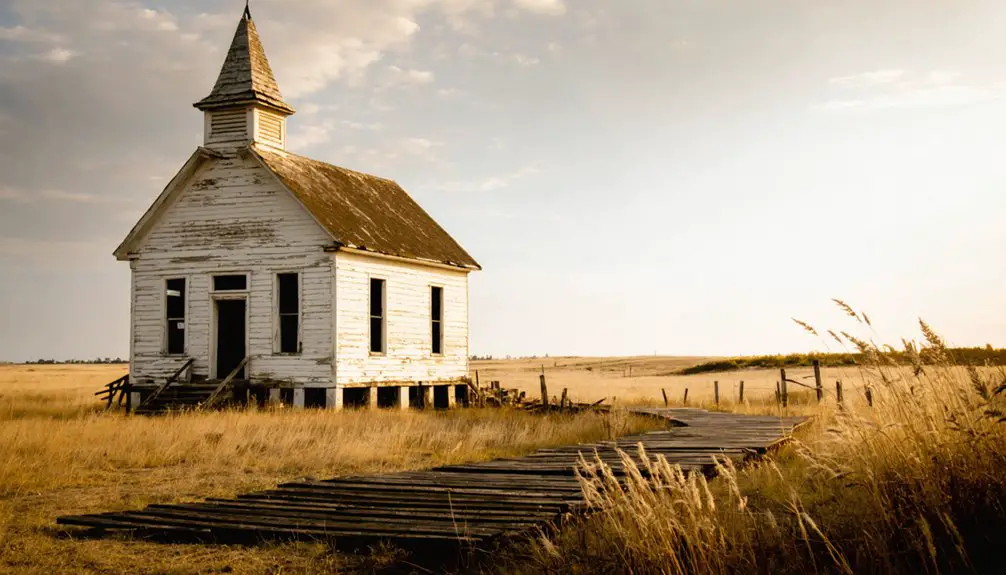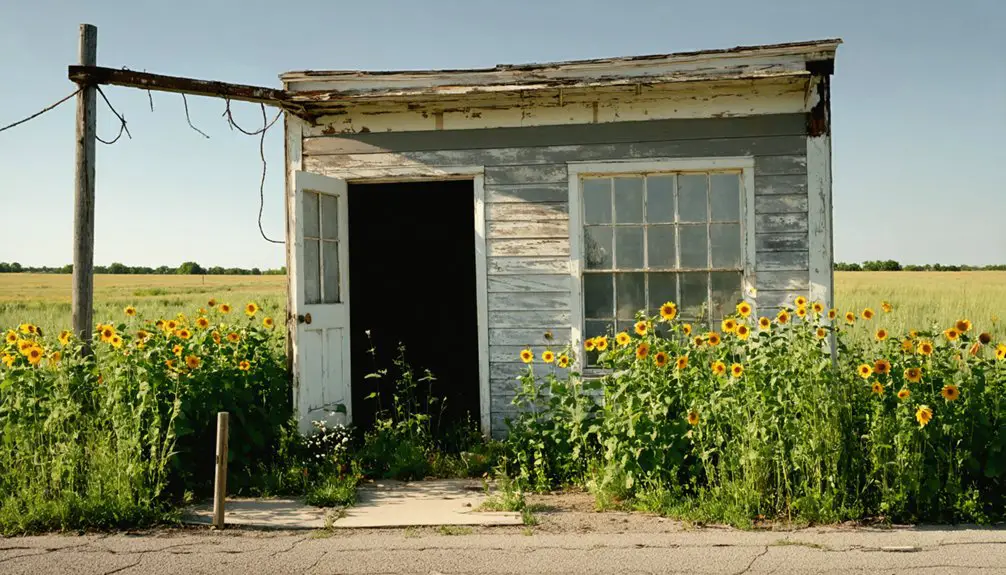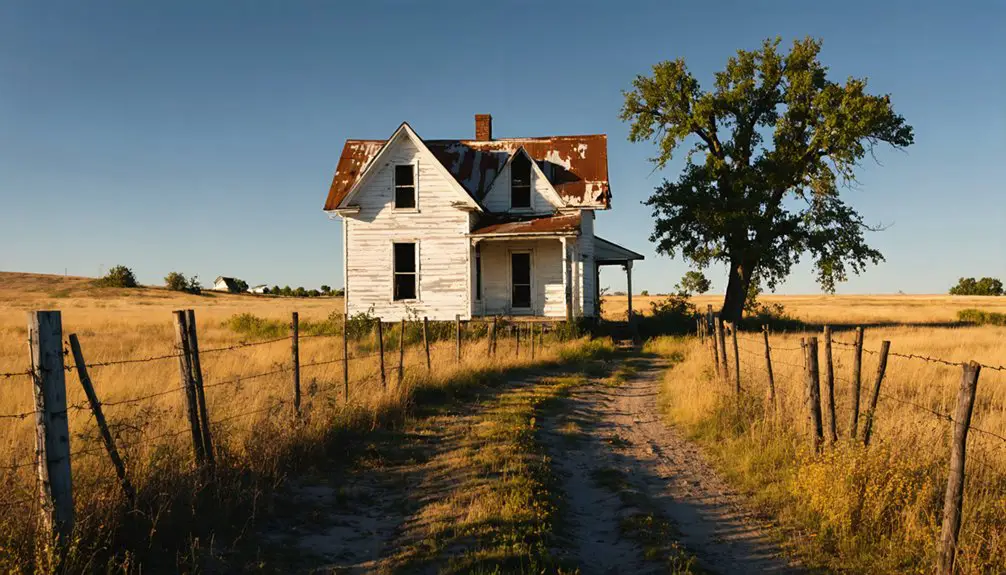You’ll find Chase, Oklahoma’s remains in Lincoln County, where it began as a railroad stop before becoming the all-Black settlement of Beland in 1908. Civil rights attorney Cornelius Jones purchased the town for $4,000 in 1906, promoting it through Black newspapers as a self-sufficient community centered on cotton farming. While the post office closed in 1926 and the town gradually declined, Chase’s story captures a powerful chapter in Oklahoma’s African-American heritage.
Key Takeaways
- Originally established in Lincoln County, Oklahoma Territory, Chase was renamed to Beland in 1908 after Cornelius Jones purchased it for $4,000.
- The town was promoted as an all-Black settlement through African-American newspapers, emphasizing self-sufficiency and economic independence.
- Cotton agriculture formed the economic backbone, while nearby oil discoveries in the 1920s provided additional opportunities for growth.
- The post office closed in 1926, marking a significant turning point in the community’s decline.
- Limited transportation infrastructure, flooding, and population exodus to urban centers eventually led to the town’s abandonment.
Origins and Early Settlement
While many Oklahoma towns emerged from the famous land runs of the late 19th century, Chase took root in Lincoln County as part of the broader settlement of Oklahoma Territory.
Chase’s establishment in Lincoln County came as settlers steadily moved into Oklahoma Territory, rather than through the dramatic land runs.
You’ll find the town’s origins deeply tied to the transformation of Native American lands into homesteads for European-American settlers, who were drawn by the promise of new opportunities.
As you explore the settler experiences in Chase, you’ll discover they focused primarily on agricultural practices, establishing farms and raising livestock. Like many of the state’s estimated two thousand ghost towns, Chase would eventually face decline and abandonment.
The arrival of the railroad helped connect these early pioneers to wider markets, though Chase remained modest in size.
The community’s first buildings reflected frontier practicality – simple wood-frame structures housing essential services like a general store and blacksmith shop, serving the few dozen families who’d made Chase their home. The discovery of oil deposits nearby would later reshape the town’s trajectory, as it did for many Oklahoma communities.
From Chase to Beland: A Name’s Evolution
The change from Chase to Beland in 1908 marked more than a mere post office name change – it represented a fresh identity under Cornelius Jones’ ambitious leadership.
You’ll find the community’s shift in name coincided with Jones’ purchase of the town in 1906 for $4,000, launching an era of active promotion in black-owned newspapers across the South.
While Chase’s original roots stretched back to 1903, the rebranding as Beland signaled Jones’ vision for a thriving African-American settlement in Oklahoma Territory. Today, like many similar settlements, it stands as a ghost town, testament to the broader pattern of population decline in early Oklahoma communities.
Post Office Name Switch
During a pivotal period in 1908, Chase’s post office underwent a significant name change to Beland, marking a transformative chapter in this Oklahoma community’s history.
You’ll find the name significance deeply rooted in postal efficiency concerns, as federal authorities often discouraged duplicate post office names within states to prevent mail delivery confusion.
The timing coincided with African-American attorney Cornelius Jones‘s ownership of the town, who’d purchased it in 1906 for $4,000. Jones actively promoted the community through black-owned newspapers, making the postal name switch particularly meaningful for the town’s identity and future.
While the post office initially thrived under its new name, it ultimately closed in 1926, reflecting broader changes in the community’s significance and population.
Community Identity Through Names
In a defining moment of African-American entrepreneurship, Chase’s evolution into Beland in 1908 represented far more than a simple name change on Oklahoma maps.
When Cornelius Jones purchased the town in 1906, he recognized that name significance would play a vital role in attracting Black settlers and investors to this promising community. Like the early French nobility that first bore the name, the town’s new identity carried aspirations of prestige and success.
The shift to “Beland” symbolized a fresh identity formation for the town’s residents, marking their independence and aspirations for economic self-sufficiency.
You’ll find that this strategic rebranding appeared in Black-owned newspapers across southern states, promoting land sales and community development.
While Beland’s physical presence may have faded into ghost town status by 1926, its name stands as a powerful reflection of African-American determination to build thriving, self-sustaining communities during an era of segregation.
Original Roots to Rebirth
Nestled eight miles southwest of Muskogee, Oklahoma, Chase emerged in 1903 as a modest African-American settlement with ambitious dreams.
Similar to the challenges faced by Griggs, Oklahoma, which lost its post office in 1973, this community struggled to maintain essential services for residents.
The settlement patterns shifted dramatically in 1906 when Cornelius Jones, a successful black attorney and businessman, purchased the entire town for $4,000.
You’ll find that Jones’s vision for the community led to aggressive marketing campaigns in black-owned southern newspapers, attracting new settlers seeking freedom and opportunity.
Like many Oklahoma communities that faced decline due to toxic contamination, Chase gradually lost its population as environmental concerns mounted in the region.
The Vision of Cornelius Jones
While many entrepreneurs sought financial gain in Oklahoma’s early settlements, Cornelius J. Jones envisioned something far more meaningful. As a successful African-American attorney and businessman, he purchased Chase for $4,000 in 1906, aiming to create a haven of community empowerment and racial autonomy for black settlers.
You’ll find Jones’s dedication to this vision reflected in his strategic approach. He promoted Chase through black-owned newspapers across the South, encouraging African Americans to build their futures through land ownership.
His background as a civil rights attorney and Republican legislator from Mississippi shaped his understanding of what freedom truly meant – the ability to govern oneself and create economic independence. After serving as school principal in Mayersville, Jones developed a deep appreciation for the power of self-governance and education in uplifting communities.
When he renamed the town Beland in 1908, it represented his ongoing commitment to developing a self-sufficient black community.
Life in an All-Black Oklahoma Town

Life in Chase reflected the broader experience of Oklahoma’s all-Black towns, where African American settlers created thriving, self-sufficient communities despite external challenges.
You’d find farmers working the rich soil, entrepreneurs running local businesses, and children attending schools transferred from tribal missions to freedmen control.
Cultural preservation remained at the heart of daily life, with churches serving as crucial gathering spaces and newspapers connecting residents to the broader African American community.
Community resilience shone through as residents established their own governance, built essential services, and maintained strong cultural identities. Post-statehood migration to urban areas gradually reduced the town’s population as residents sought new opportunities.
Despite adversity, Chase’s Black residents forged a resilient community through self-governance, infrastructure development, and unwavering cultural pride.
You’d witness a town deeply invested in self-sufficiency, where African American leaders actively shaped political discourse and economic development, creating a space where Black families could thrive freely without the constant threat of discrimination faced elsewhere.
The town’s economic foundation relied heavily on cotton agriculture, following the pattern of other All-Black settlements throughout Oklahoma.
Economic Growth and Development
During Chase’s peak years, the town’s economic significance centered on agriculture and local commerce, though nearby oil discoveries in Osage County during the 1920s brought additional opportunities.
You’d have seen the town’s growth reflect the broader resource wealth that transformed Oklahoma’s landscape, as Chase’s residents benefited from the ripple effects of regional oil production and increased trade activity.
The town’s proximity to rail transportation helped sustain its economic dynamism, allowing farmers to ship their goods and connecting Chase to wider markets.
Like many Oklahoma communities, Chase experienced the classic boomtown dynamics of rapid growth followed by eventual decline, similar to how the nearby town of Whizbang produced up to 2,500 barrels daily.
While the town didn’t directly depend on oil extraction, the prosperity of surrounding oil fields contributed to Chase’s commercial activity through increased regional trade and population movement.
Transportation and Infrastructure

As railroads shaped Oklahoma’s territorial expansion, Chase’s transportation infrastructure revolved around its strategic position along the rail line. The railroad impact proved crucial to the town’s early growth, enabling the movement of goods and passengers while supporting local commerce.
You’ll find that basic infrastructure, including sawmills and public buildings, emerged to serve railroad-related activities.
However, Chase’s fortunes shifted with changing transportation patterns. Limited highway connectivity isolated the community from major trade routes, while dependence on irregular stage and wagon services couldn’t sustain local businesses.
When flooding damaged transportation infrastructure, the town faced mounting challenges. Roads remained unpaved, and maintenance became sporadic.
These infrastructure limitations, combined with shifting railroad services, ultimately contributed to Chase’s decline into a ghost town.
The Town’s Gradual Decline
When you look at Chase’s decline, you’ll find it followed a familiar pattern seen in many Oklahoma ghost towns where the loss of economic opportunities triggered a rapid population exodus.
The town’s community fabric began unraveling as families moved away in search of better prospects, leaving behind empty storefronts and abandoned homes.
As fewer residents remained to support local businesses and maintain community institutions, Chase’s transformation from a living town to a ghost town accelerated through a self-reinforcing cycle of departures and diminishing services.
Population Loss Factors
While several Oklahoma towns managed to sustain their populations through economic diversification, Chase’s decline stemmed from a perfect storm of challenges that plagued many similar communities in the region.
You’ll find that Chase’s demographic shifts mirrored the classic pattern of resource-dependent towns: as natural resources dwindled, jobs disappeared, triggering a mass exodus of workers and their families.
The town’s economic shifts were further complicated by its limited transportation infrastructure, making it difficult to attract new industries or maintain existing businesses.
Like many small communities of its era, Chase couldn’t compete with the growing appeal of urban centers, which offered better employment prospects and modern amenities.
The exodus of younger residents left behind an aging population, further diminishing the town’s chances for revitalization.
Community Support Eroded
Once the economic pillars of Chase began to crumble, the town’s community support system quickly unraveled. As jobs disappeared and families moved away, the vibrant social networks that had defined daily life began to fade.
You’d no longer find the familiar faces at church gatherings or school events that once fostered community engagement. The closure of local institutions hit particularly hard. Without schools serving as social hubs, neighbors lost their primary meeting grounds.
The disappearance of telephone party lines, which had kept residents connected through shared conversations, further isolated those who remained. Churches and social clubs that had united the community shut their doors as membership dwindled.
The loss of these gathering spaces weakened the informal support systems that had helped residents weather tough times together.
Legacy of Oklahoma’s Black Communities

As America’s post-Civil War landscape evolved, Oklahoma emerged as a beacon of Black autonomy and self-determination, fostering over 50 all-Black towns between 1865 and 1920 – more than any other state in the nation.
You’ll find a reflection of Black resilience in these communities, where freed slaves of the Five Civilized Tribes and their descendants built thriving centers of culture and commerce.
Despite facing brutal Jim Crow laws and devastating racial violence, including the 1921 Tulsa Race Massacre, these towns showcased African American entrepreneurship and determination.
Though most declined by the 1940s, their cultural heritage lives on in surviving communities like Boley, Langston, and Rentiesville.
These historic spaces remind you of what’s possible when people unite for economic independence and mutual protection, even in the face of systemic oppression.
Present-Day Remnants and Historical Significance
Today, when you visit the ghost town of Chase, Oklahoma – later renamed Beland – you’ll find just a handful of deteriorating structures standing approximately 8 miles southwest of Muskogee.
While ghost town tourism draws curious visitors to explore Oklahoma’s abandoned settlements, Chase holds special significance as a symbol of African-American entrepreneurship and determination. Founded in 1903 and purchased by black attorney Cornelius Jones in 1906, the town represented a bold vision of self-sustaining black commerce during the segregation era.
Though the community declined after losing its post office in 1926, its remaining structures serve as powerful reminders of cultural preservation efforts. Chase stands among an estimated 2,000 Oklahoma ghost towns, but its unique legacy in African-American history sets it apart from typical boom-and-bust narratives.
Frequently Asked Questions
What Happened to the Original Residents of Chase After Its Decline?
You’ll find that resident memories reveal they scattered to nearby towns seeking better opportunities, with relocation stories showing families moved toward cities or oil boomtowns for economic stability.
Are There Any Surviving Photographs of Chase During Its Peak Years?
Like faded footprints in time, you won’t find any confirmed surviving photographs of Chase’s peak years. Despite its historical significance, visual documentation of this community remains elusive in archives and collections.
What Businesses and Industries Operated in Chase Before Its Abandonment?
You’d find general stores, blacksmith shops, and farming-related businesses that supported local agricultural practices. While lacking rail transport, the town sustained itself through small-scale commerce and subsistence farming operations.
Did Chase Have Its Own School System During Its Active Years?
Like many frontier towns, Chase’s education system thrived with local teachers serving the community. You’ll find historical patterns suggesting Chase maintained its own schoolhouse during its peak settlement years.
Were There Any Notable Events or Celebrations Regularly Held in Chase?
You won’t find records of local festivities or annual gatherings in Chase’s history. The small rail-dependent settlement likely had informal community gatherings, but no documented regular celebrations have been discovered.
References
- https://en.wikipedia.org/wiki/Beland
- https://en.wikipedia.org/wiki/List_of_ghost_towns_in_Oklahoma
- https://www.kosu.org/local-news/2014-05-23/ghost-towns-all-black-oklahoma-towns
- https://www.okhistory.org/publications/enc/entry?entry=GH002
- https://www.youtube.com/watch?v=kPPeKY1mlzc
- https://okmag.com/blog/a-ghostly-site/
- https://www.youtube.com/watch?v=5d-wHDTIbb0
- https://digitalprairie.ok.gov/digital/api/collection/stgovpub/id/310251/download
- https://oklahoma.gov/content/dam/ok/en/banking/documents/closed_merged_banks_.pdf
- https://digitalprairie.ok.gov/digital/api/collection/stgovpub/id/450756/download



